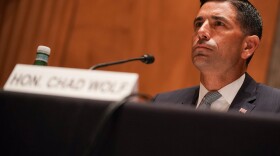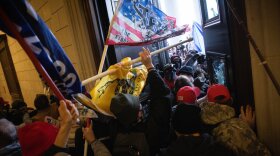Updated at 3:05 p.m. ET
The top federal prosecutor for the District of Columbia said Friday that investigators have not uncovered direct evidence at this point of any "kill/capture teams" targeting elected officials during the U.S. Capitol insurrection, contradicting allegations made earlier by federal prosecutors in Arizona.
U.S. prosecutors in Arizona said Thursday in a court filing against Jacob Chansley, also known as the "QAnon Shaman," that they have "strong evidence" members of the pro-Trump mob wanted to "capture and assassinate" officials.
Michael Sherwin, acting U.S. attorney for the District of Columbia, attributed what he called the "disconnect" in Arizona, and at least one other district, to the sprawling and complex nature of the investigation. There are preliminary hearings taking place in districts across the United States.
"At some of those hearings, there were other prosecutors, there may be a disconnect, may be adding information that's not directly related to what we have," Sherwin said at a news conference.
''It's only a matter of time"
Chansley, the subject of the motion filed in Arizona, wore horns, face paint and fur on Jan. 6 as he stood on the Senate dais – where he left a threatening note for Vice President Pence, according to federal prosecutors in that state.
"It's only a matter of time, justice is coming," the handwritten note to Pence read, according to the court document. The note was left at the spot where, moments earlier, Pence had been poised to preside over a joint session to certify President-elect Joe Biden's victory over President Trump. Chansley told the FBI he believes Pence is a "child-trafficking traitor."
Chansley told investigators that he didn't mean the message to Pence as a threat.
"The Government strongly disagrees," prosecutors said.
The U.S. attorney's office in Arizona filed the memorandum Thursday as part of its argument against releasing Chansley while his case proceeds. He was slated to appear at a detention hearing Friday afternoon in Phoenix.
Chansley is charged with two felonies: obstructing the conduct of a law enforcement officer and obstructing an official proceeding. Prosecutors say that as he committed those actions, Chansley was also carrying a dangerous weapon – specifically, "a six-foot spear."
Prosecutors say Chansley should remain in custody for a variety of reasons, including his part in the riot and his avowed intent to return to Washington to protest Biden's upcoming inauguration.
"I'll still go, you better believe it," he is quoted telling the FBI. "For sure I'd want to be there, as a protestor, as a protestor, f***in' a."
The U.S. attorney's office also says that Chansley would not likely conform to court-imposed conditions on his release, noting that while in custody, he has refused to eat anything other than organic food. Prosecutors also note that Chansley has shown he can travel without being traced. And because he is widely associated with the horns-and-fur costume and face paint he wore at the Capitol, prosecutors say, Chansley "is virtually unidentifiable when not wearing it."
The memorandum, like other documents prosecutors have filed in Chansley's case, notes he refers to himself and other rioters as "patriots." The filing gives new details about how prosecutors view the insurrection – a term the U.S. attorney's office used repeatedly in its filing.
"Chansley has made himself the symbol of a radicalized insurrection movement, and has professed his intent to act in the future as he did at the Capitol on January 6," the memorandum says.
It notes Chansley's status as a "shaman" within QAnon, which the prosecutors variously define as "a dangerous extremist group ... founded on an imaginary conspiracy theory," and a cult that "preaches debunked and fictitious anti-government conspiracy theories that a deep state is out to take down the current administration."
Describing the threat it says the defendant poses, the memo says, "Strong evidence, including Chansley's own words and actions at the Capitol, supports that the intent of the Capitol rioters was to capture and assassinate elected officials in the United States Government. "
Chansley and dozens of others who breached security at the Capitol have been arrested in the past week. In many cases, they have been identified by citizens and authorities from photos and videos taken inside lawmakers' offices and other areas in the congressional complex.
The attack on the Capitol has been linked to five deaths, including U.S. Capitol Police Officer Brian Sicknick and a woman whom police shot as she tried to breach a barricaded door.
Federal prosecutors say insurrectionists' attempts to violently overthrow the U.S. government are not over, noting an increase in online rhetoric since Jan. 6 and stating, "Media and FBI reports have detailed carefully-planned insurrection attempts scheduled throughout the country in the coming weeks at every state capital, including the [Arizona] capitol."
Arguing that Chansley poses a flight risk, the court filing says he does not have a stable job that would require him to remain in Arizona. And because of Chansley's status within QAnon, the court filing says, he has "the ability to raise large sums of money for travel (and other activities) quickly through non-traditional means."
Was there coordination?
Federal prosecutors are also still working to determine whether there was premeditation or coordination among groups to storm the Capitol, Sherwin, the acting U.S. attorney for the District of Columbia, said Friday.
"There are bread crumbs of organization in terms of maybe what was taking place outside the Capitol and inside with perhaps some type of communication, with core groups of people ingressing into the Capitol and some coordinated activity of the individuals within the Capitol," Sherwin said.
"And that is a tier-one, top priority for both the U.S. attorney's office and federal law enforcement partners to see whether there was this overarching command and control, and whether there were these organized teams that were organized to breach the Capitol," Sherwin said.
He added that it's "going to take weeks, if not months, to find out the motivation of some of those groups."
NPR's Ryan Lucas contributed to this report.
Copyright 2021 NPR. To see more, visit https://www.npr.org. 9(MDA3MzEzNjc2MDEzMDI2Mzc4OTc4NTFmNg001))











